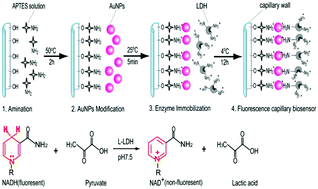Our official English website, www.x-mol.net, welcomes your
feedback! (Note: you will need to create a separate account there.)
Development of a fluorescent capillary biosensor based on self-assembled AuNP/LDH for micro-volume intracellular pyruvate†
Analyst ( IF 3.6 ) Pub Date : 2017-12-12 00:00:00 , DOI: 10.1039/c7an01566f Ya-Xiong Luo 1, 2, 3, 4 , Qiao-Jing Li 2, 4, 5, 6 , Lang Zhou 2, 4, 5, 6 , Yong-Sheng Li 2, 4, 5, 6 , Xiu-Feng Gao 1, 2, 3, 4
Analyst ( IF 3.6 ) Pub Date : 2017-12-12 00:00:00 , DOI: 10.1039/c7an01566f Ya-Xiong Luo 1, 2, 3, 4 , Qiao-Jing Li 2, 4, 5, 6 , Lang Zhou 2, 4, 5, 6 , Yong-Sheng Li 2, 4, 5, 6 , Xiu-Feng Gao 1, 2, 3, 4
Affiliation

|
Herein, a fluorescent capillary biosensor was developed for quantifying micro-volume intracellular pyruvate (PA), in which AuNPs and lactate dehydrogenase (LDH) were modified on the inner surface of an amination capillary (20 μL) via a self-assembly technique. The PA concentration was quantified by the change in the value of the fluorescence of NADH after sucking a mixed solution of the sample and NADH into the biosensor. This study investigated factors including the degree of protonation of the amino groups on the surface of the capillary, the AuNP concentration and time for self-assembly, the activity concentration and time for the LDH self-assembly, the flow rate and acidity for LDH immobilization, pH, temperature, and reaction time for the NADH/PA/LDH reaction system. Under the optimized conditions, the linear response range of the biosensor towards PA was 2.5–120 μmol L−1, in which the determination limit and detection limit were 2.5 and 0.75 μmol L−1, respectively. The biosensor could be reused more than 41 times when its relative standard deviation (RSD) was controlled at less than 1.5%. At room temperature (approximately 25 °C), the intracellular PA in the erythrocyte of a healthy person was measured using the biosensor, and the PA content was observed to be 241.76 ± 68.05 μmol L−1 (n = 8). The standard addition recovery was 95–106%. Employment of the AuNPs in the PA biosensor not only improved the affinity of the immobilized LDH towards PA and its stability, but also significantly enhanced the service life of the PA biosensor.
中文翻译:

基于自组装AuNP / LDH的荧光毛细管生物传感器的开发,用于微小体积细胞内丙酮酸†
在本文中,荧光毛细管生物传感器定量微体积的细胞内丙酮酸(PA)中,其中的AuNP和乳酸脱氢酶(LDH)进行了修改的胺化毛细管(20μL)的内表面上显影经由自组装技术。通过将样品和NADH的混合溶液吸入生物传感器后,NADH荧光值的变化来定量PA浓度。这项研究调查了包括毛细管表面氨基的质子化程度,AuNP浓度和自组装时间,LDH自组装的活性浓度和时间,固定化LDH的流速和酸度在内的因素。 ,pH,温度和NADH / PA / LDH反应系统的反应时间。在最佳条件下,生物传感器对PA的线性响应范围为2.5–120μmolL -1,其中测定限和检测限分别为2.5和0.75μmolL -1, 分别。当其相对标准偏差(RSD)控制在1.5%以下时,该生物传感器可以重复使用41次以上。在室温(约25°C)下,使用生物传感器测量健康人的红细胞中的细胞内PA,PA含量为241.76±68.05μmolL -1(n = 8)。标准添加回收率为95–106%。在PA生物传感器中使用AuNPs不仅可以提高固定化LDH对PA的亲和力和稳定性,而且可以显着提高PA生物传感器的使用寿命。
更新日期:2017-12-12
中文翻译:

基于自组装AuNP / LDH的荧光毛细管生物传感器的开发,用于微小体积细胞内丙酮酸†
在本文中,荧光毛细管生物传感器定量微体积的细胞内丙酮酸(PA)中,其中的AuNP和乳酸脱氢酶(LDH)进行了修改的胺化毛细管(20μL)的内表面上显影经由自组装技术。通过将样品和NADH的混合溶液吸入生物传感器后,NADH荧光值的变化来定量PA浓度。这项研究调查了包括毛细管表面氨基的质子化程度,AuNP浓度和自组装时间,LDH自组装的活性浓度和时间,固定化LDH的流速和酸度在内的因素。 ,pH,温度和NADH / PA / LDH反应系统的反应时间。在最佳条件下,生物传感器对PA的线性响应范围为2.5–120μmolL -1,其中测定限和检测限分别为2.5和0.75μmolL -1, 分别。当其相对标准偏差(RSD)控制在1.5%以下时,该生物传感器可以重复使用41次以上。在室温(约25°C)下,使用生物传感器测量健康人的红细胞中的细胞内PA,PA含量为241.76±68.05μmolL -1(n = 8)。标准添加回收率为95–106%。在PA生物传感器中使用AuNPs不仅可以提高固定化LDH对PA的亲和力和稳定性,而且可以显着提高PA生物传感器的使用寿命。









































 京公网安备 11010802027423号
京公网安备 11010802027423号